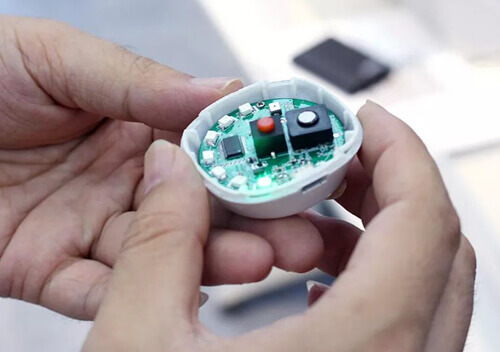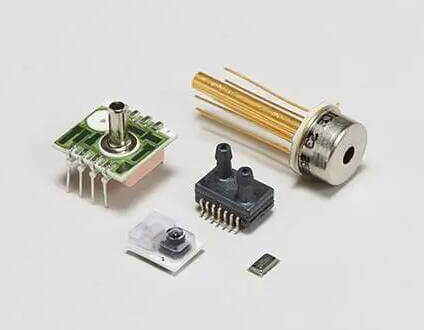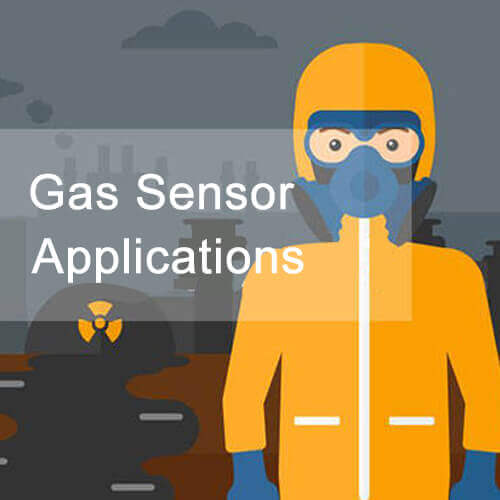Gas sensors application in a wide range. Mainly used to detect the concentration of gas, such as carbon dioxide, oxygen, nitrogen, argon, etc. In the industrial field, gas sensors are often used in gas leak detection, industrial ventilation systems, and gas sensor fault detection. In the medical field, gas sensors also have high application value, mainly used to detect tumor gas, smoke gas, etc. Gas sensors are also widely used in the field of security, such as gas sensors for door and window detection, gas sensors for fire warning and so on.
Gas Sensors History
In 1815, the renowned British chemist Sir Humphry Davy invented the safe mining lamp known as the Davy lamp, which could be used in environments with coal mine gas. The introduction of the Davy lamp eliminated the danger of coal mine gas explosions caused by candles or torches used for illumination. Alongside the presence of gas, carbon monoxide was also an extremely hazardous gas. As carbon monoxide is colorless and odorless, it was imperceptible, leading workers to use small animals for safety testing. For instance, the “canary in the coal mine” was used to detect deadly carbon monoxide in enclosed environments. Later, carbon monoxide detection tubes were invented for testing carbon monoxide levels, marking the beginning of gas detection devices. Subsequently, as the dangers of oxygen deficiency became better understood, oxygen-detection colorimetric tubes were also developed.
In 1926, a series of oil ship explosions prompted the Standard Oil Company of California to begin research and development on combustible gas reading indicators.
In 1927, portable combustible gas sensors were invented.
In 1939, an interferometric gas detection meter using the principle of light diffraction was invented to detect gasoline vapors and methane.
In 1960, the first generation of electrochemical oxygen sensors appeared and was applied in portable oxygen detection instruments.
In 1968, metal oxide sensors were introduced.
In 1969, more chemical sensors for toxic gases emerged.
In 1981, electrochemical sensors for oxygen and various other toxic gases were introduced, leading to the establishment of numerous internationally recognized manufacturers of gas detection instruments.
Which Gases Can be Detected?
In addition to the common colorless and odorless gases such as carbon dioxide and oxygen, other detected gases are mainly divided into three categories: flammable gases, toxic gases and VOC (volatile organic compounds).
Combustible Gases
These are the gases most commonly encountered in gas detection instruments. Combustible gases refer to gases that can form a homogeneous mixture with air (or oxygen) within a certain concentration range. When exposed to a source of ignition, these gases can explode and release a significant amount of energy during the combustion process. Such gases are prevalent in industries like petrochemicals and manufacturing. Common examples of combustible gases include hydrogen (H2), methane (CH4), ethane (C2H6), propane (C3H8), butane (C4H10), ethylene (C2H4), propylene (C3H6), acetylene (C2H2), and more.
Toxic Gases
Toxic gases are substances that can harm human health and lead to poisoning. They are primarily divided into irritant gases (which irritate the eyes and respiratory mucous membranes) and asphyxiant gases (which can cause oxygen deficiency in the body). These gases can directly harm humans and pose significant dangers. Common toxic gases include carbon monoxide (CO), hydrogen sulfide (H2S), ammonia (NH3), chlorine (Cl2), sulfur dioxide (SO2), nitrogen dioxide (NO2), nitric oxide (NO), carbon dioxide (CO2), and others.
Volatile Organic Compounds (VOCs)
VOCs refer to organic liquids or solids that can spontaneously evaporate at room temperature and pressure. They are often referred to as organic solvents. Common examples of VOCs that gas detectors can monitor include gasoline, diesel, benzene, crude oil, paints, and more.
Gas Sensors Application
As a type of converter that transforms gas concentrations into corresponding electrical signals, gas sensors application in various domains such as homes, industries, and environmental monitoring.
Gas Sensors Application in Homes
Research from the World Health Organization shows that indoor air pollution can be 2 to 5 times worse than outdoor air pollution. And people spend more than 80% of their time indoors, monitoring indoor air quality is crucial. Gas sensors application in homes for detecting leaks of natural gas, liquefied petroleum gas, and harmful gases produced by incomplete combustion of city gas in kitchens. Gas measurement units can be installed in microwaves to detect gases generated during food cooking, enabling automatic control of microwave cooking processes. Carbon dioxide sensors, smoke sensors, ozone sensors, etc., can be installed in residences, buildings, meeting rooms, and public entertainment places to regulate the automatic operation of air purifiers or electric fans. In some high-rise buildings, gas sensors can also be used to detect early signs of fires and trigger alarms.

Gas Sensors Application in Industries
In the industrial sector, gas sensors are primarily used in the petrochemical industry. Sensors like carbon dioxide sensor, ammonia sensor, nitrogen oxide sensor, etc., are installed in areas where harmful gases like carbon dioxide, ammonia, chlorine, etc., tend to accumulate. Additionally, gas sensors are used to detect toxic gases like organic solvents and phosphine in semiconductor and microelectronics industries. In the power sector, hydrogen gas sensors can detect hydrogen gas produced during the degradation of transformer oil.
Gas Sensors Application in Agriculture
Gas sensors can be used to monitor the concentrations of gases such as carbon dioxide, oxygen, and ethylene in greenhouses. This helps provide optimal growth conditions for plants and promotes the maturation of fruits and vegetables. In greenhouses, when the carbon dioxide content in the air is too low, it needs to be supplemented manually. A lack of carbon dioxide can slow down the process of photosynthesis, affecting plant growth. Therefore, carbon dioxide sensors are often installed in greenhouse environments to accurately control carbon dioxide concentrations.
Gas Sensors Application in Livestock Farming
In livestock farms, a significant amount of gases like hydrogen sulfide, ammonia, and carbon dioxide are produced due to animal respiration and the decomposition of organic matter. The accumulation of these harmful gases can lead to accidents, so corresponding gas sensors are installed to detect harmful gas concentrations and ensure timely ventilation.
Gas Sensors Application in Medicine
In the field of medical sensors, medical carbon dioxide sensors have various applications, particularly in scenarios like ventilators and anesthesia equipment, where they monitor the vital signs of patients. Gas sensors are also used to monitor patient’s blood oxygen levels. By detecting the patient’s respiratory oxygen concentration and carbon dioxide concentration, blood oxygen levels can be calculated. This data helps doctors understand whether the patient’s respiratory function is normal, enabling them to take timely therapeutic measures.

Gas Sensors Application in Food Industry
In the food production process, inert protective gases are often injected into food packaging to extend the shelf life of products. Additionally, to assess the quality of packaged goods, producers need to perform sampling and testing. Gas sensors can detect whether the gas concentrations in the food are within acceptable limits. During transportation, vegetables and fruits continue to undergo metabolic processes, consuming oxygen and producing heat, CO2, humidity, and ethylene gas. To ensure the freshness of produce, controlling the gas environment is essential during transportation. By reducing the oxygen concentration from 21% to around 2%, the metabolic rate can be decreased by about 30%, preserving the freshness of fruits and vegetables.
Gas Sensors Application in Environmental Monitoring
Environmental issues have become a global focus, with many countries investing in environmental monitoring and management. Gas sensors play a crucial role in this field. For instance, sensors are used to detect gases like nitrogen oxides, sulfur oxides, hydrogen chloride, and others that contribute to acid rain. CO2 sensors are employed to monitor CO2 concentrations, aiding in scientific assessments and research related to the greenhouse effect. Air quality sensors are used to measure particulate matter concentrations in the environment. Gas sensors application are expanding rapidly as environmental concerns continue to grow.
Gas Sensors Application in Automotive Industry
There are numerous types of sensors used in automobiles, and gas sensors are a vital component. According to statistics, gas sensors constitute over 50% of the sensors used in automotive engines. From an external perspective, automobile exhaust gases contain various substances such as nitrogen oxides (NOx), particulate matter (PM), and hydrocarbons (HC). Different sensors are needed to detect these substances, aiming to improve combustion efficiency and energy conversion rate of automobile fuel, while reducing emissions of polluting gases. Currently used gas sensors in vehicles mainly include nitrogen oxide sensors, ammonia sensors, and particulate matter sensors.
From an internal perspective, sources of pollution within vehicles mainly come from the vehicle structure and interior materials. Toxic substances like formaldehyde, xylene, and benzene can affect human health. Another common hazardous gas in cars is carbon monoxide, primarily originating from the vehicle’s engine and exhaust. It can also be produced when using the car’s air conditioning system while parked. Accumulation of carbon monoxide inside the car can lead to poisoning and death due to the inhalation of this colorless, odorless toxic gas.











